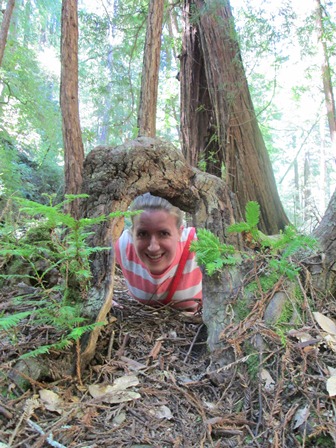Spanning the Atlantic from New York to Oxford, the Global Online Product Marketing team is a motley bunch with a love for all things digital. Custodians of a diverse portfolio of online offerings, they definitely know what’s what on the web. Read on for some literary and digital favourites from the team, and a glimpse into the minds of our online gurus here at Oxford University Press.
The post Getting to know the Online Product Marketing Team appeared first on OUPblog.

By Elyse Turr
San Francisco, here we come.
Oxford is excited for the upcoming annual conference of the American Society for Environmental History in San Francisco this week: 12-16 March 2014. The theme of the conference is “Crossing Divides,” reflecting the mixed history of the discipline and California itself.
We’ll be at the Opening Reception, co-sponsored by Oxford University Press, MIT, University of Delaware, and the Winslow Foundation on Wednesday, 12 March 2014 from 6:00-8:00 p.m. in the Cyril Magnin Ballroom.
Stop by Oxford’s display in the Exhibit hall. We’ll have hundreds of books on display, including several hot off the presses like Jared Orsi’s Citizen Explorer: The Life of Zebulon Pike, Cecilia M. Tsu’s Garden of the World: Asian Immigrants and the Making of Agriculture in California’s Santa Clara Valley, and Kendra Smith-Howard’s Pure and Modern Milk: An Environmental History since 1900.
 Pick up a complimentary copy of Environmental History and other key Oxford journals at the booth. The most current issue features new articles on the environmental history of work, environmental politics and corporate real estate development, the shift to steam power in water reservoirs, and how skiing transformed the Alps. The editors have also compiled a special conference-companion virtual issue that draws on the theme of “Crossing Divides.” And for your teaching and research needs we’re offering free trials of Oxford’s online resources. Check out census data going back to 1790 with Social Explorer or assign sections, chapters, or full texts of books with Oxford Scholarship Online. Pick up a free trial access card at the booth.
Pick up a complimentary copy of Environmental History and other key Oxford journals at the booth. The most current issue features new articles on the environmental history of work, environmental politics and corporate real estate development, the shift to steam power in water reservoirs, and how skiing transformed the Alps. The editors have also compiled a special conference-companion virtual issue that draws on the theme of “Crossing Divides.” And for your teaching and research needs we’re offering free trials of Oxford’s online resources. Check out census data going back to 1790 with Social Explorer or assign sections, chapters, or full texts of books with Oxford Scholarship Online. Pick up a free trial access card at the booth.
 ASEH 2014 is offering a number of field trips, but the one we’re fired up about is a field trip to Muir Woods on Friday, 14 March 2014. In 2008 Oxford was proud to publish Donald Worster’s biography of John Muir, A Passion for Nature: The Life of John Muir. Worster discusses Muir’s appreciation for and belief in the power of the forest in this passage:
ASEH 2014 is offering a number of field trips, but the one we’re fired up about is a field trip to Muir Woods on Friday, 14 March 2014. In 2008 Oxford was proud to publish Donald Worster’s biography of John Muir, A Passion for Nature: The Life of John Muir. Worster discusses Muir’s appreciation for and belief in the power of the forest in this passage:
“Nature, particularly its forests, offered an ideal of harmony to a nation torn apart by conflict between capital and labor, country and city, imperialists and anti-imperialists. That harmony was first and foremost one of beauty; nothing in nature was ugly or discordant, a lesson that could be learned by hiking a trail into the Sierra or standing at the rail of a steamer along the Alaskan coast. The challenge was how to help American society achieve that same degree of moral and aesthetic unity.
“Violent confrontation was not the way to achieve ecological harmony, a beautiful landscape, or a decent civilization. One must start by resolving to conserve the natural world for the sake of human beings and other forms of life. Conservation offered both an economic and aesthetic program of social reform—learning to use natural resources more carefully, for long-term renewability, and learning to preserve wild places where humans could go to learn about how nature constructs harmony. Muir tried, as other green men did, to push conservation in both directions. Achieve these reforms, he believed, and a truer, better democracy would evolve in which people of diverse origins, abilities, and needs would live in greater peace and mutuality, just as all the elements of nature did. If a forest could thrill the sense and still the troubled heart with its harmonies, then society could become like that forest. Such was the hope of the green men.”
—Donald Worster, A Passion for Nature: The Life of John Muir
My own first experience in Muir Woods:
I grew up in the Northeast –I’ve tapped maples looking for sap, hiked portions of the Appalachian Trail and spent enormous chunks of my childhood climbing the pine tree in our front yard–I thought I knew trees. Last Spring, while visiting friends in San Francisco, we toured Muir woods and I very quickly realized that any of the previous trees I knew were mere twigs by comparison to the majestic redwoods. It was both powerful and humbling to be among these giants, feeling dizzy trying to find their tops and small trying to wrap my arms around one and not even getting half-way. Never before had I been able to step inside a fire-charred redwood or run my hands across the hundreds of rings in a fallen tree. Muir Woods is a beautiful, peaceful place and I am very glad I was able to experience it; it was an experience I will always remember.
—Elyse Turr, History Marketing

Elyse Turr in Muir Woods
See you in San Francisco!
Elyse Turr is an Assistant Marketing Manager for history titles for Oxford University Press.
Subscribe to the OUPblog via email or RSS.
Subscribe to only American history articles on the OUPblog via email or RSS.
The post Preparing for ASEH 2014 in San Francisco appeared first on OUPblog.

By David Biale
Two years ago, I agreed to serve as the head of an international team of nine scholars from the US, UK, Poland, and Israel who are attempting to write a history of Hasidism, the eighteenth-century Eastern European pietistic movement that remains an important force in the Orthodox Jewish world today. I was perhaps not the obvious choice for this role. Although I’ve written several articles and book chapters on Hasidism, it has not been my main area of research. But Arthur Green, one of the foremost historians of Hasidism and the person who was supposed to head the team, was unable to take on the role and I had had some success as the editor of a large compendium on Jewish and Israeli culture (Cultures of the Jews: A New History). And so, my colleagues convinced me to take on the organizational and editorial work on the project.
Surprisingly, given its long history and influence, no general history of Hasidism exists. The first attempt at such a history was published in 1931 by Simon Dubnow, the doyen of Jewish history in Russia. Dubnow had begun collecting materials for a history of Hasidism in the 1890s. However, his history covered only the first half century of the movement, ending in 1815, which is when he believed the creative period of Hasidism came to an end.
If I was going to direct this ambitious project, I needed to come up to speed on the bibliography of research over the last half century. I was familiar with the major works of the older generation of scholars such as Gershom Scholem, Joseph Weiss, Rivka Schatz-Uffenheimer, and Mendel Piekarz (to name some of the most important) as well as the younger generation, some of whom are members of our team (Ada Rapoport-Albert, Moshe Rosman, and David Assaf). Although the research community working on Hasidism is relatively small, there is still an impressive body of scholarly literature that has emerged over the last few decades.
Fortunately, at about the time I accepted the invitation to direct the Hasidism project, I was also approached by Oxford University Press to serve as Editor-in-Chief of Oxford Bibliographies in Jewish Studies. My first task was to prepare a sample bibliography. So, instead of taking on a subject whose sources were at my fingertips, I decided to put together a bibliography of Hasidism, killing the proverbial “two birds with one stone” (or, as the Jewish saying has it, “to dance at two weddings”).
What emerged from this immersion in the sources was the growing sense that our new history could significantly revise the earlier scholarship. In most of the earlier studies, as well as in Hasidism’s own self-conception, the movement was founded by the Baal Shem Tov, who died in 1760. But like the historical Jesus of Nazareth, the Baal Shem Tov (also known as the Besht) wrote little and probably had no intention of founding a movement. It was only later in the eighteenth century that scattered charismatic leaders (known as rebbes in Yiddish, or zaddikim in Hebrew) began to be seen (and to see themselves) as a coherent movement. But since the Hasidim organized themselves as devoted followers of specific individuals, the movement had no central core. Each of these rebbes had his own philosophy and style of leadership, so that one should speak of Hasidism in the plural.
The nineteenth century, far from a time of stagnation, as Dubnow thought, now appears to have been the golden age of Hasidism. While it is questionable whether the majority of Eastern Jews were Hasidim, the movement spread rapidly and became even more active in areas of Poland and Galicia than in the provinces of Ukraine where it originated. In the twentieth century, Hasidism underwent a sharp decline as a result of the Bolshevik Revolution, the rise of secular Jewish politics in Poland, and the devastation of the Holocaust (see The Holocaust in Poland). Following World War II, the movement rose from the ashes in North America and Israel, in exile, as it were, from its Eastern European homeland. Today, there may be as many as three-quarters of a million Hasidim (out of 13 million Jews worldwide). But a movement that presents itself and is often seen by others as devout guardians of tradition is, in reality, something new, a product of modernity no less than Jewish secularism.
David Biale, Editor in Chief of Oxford Bibliographies in Jewish Studies, is the Emanuel Ringelblum Professor of Jewish History in the department of history of University of California Davis. He is the editor of Cultures of the Jews: A New History (Schocken Books, 2002) and the author of Blood and Belief: The Circulating of a Symbol Between Jews and Christians (University of California Press, 2008).
Developed cooperatively with scholars and librarians worldwide, Oxford Bibliographies offers exclusive, authoritative research guides. Combining the best features of an annotated bibliography and a high-level encyclopedia, this cutting-edge resource guides researchers to the best available scholarship across a wide variety of subjects.
Subscribe to the OUPblog via email or RSS.
Subscribe to only religion articles on the OUPblog via email or RSS.





 Pick up a complimentary copy of
Pick up a complimentary copy of  ASEH 2014 is offering a number of field trips, but the one we’re fired up about is a field trip to Muir Woods on Friday, 14 March 2014. In 2008 Oxford was proud to publish Donald Worster’s biography of John Muir,
ASEH 2014 is offering a number of field trips, but the one we’re fired up about is a field trip to Muir Woods on Friday, 14 March 2014. In 2008 Oxford was proud to publish Donald Worster’s biography of John Muir, 